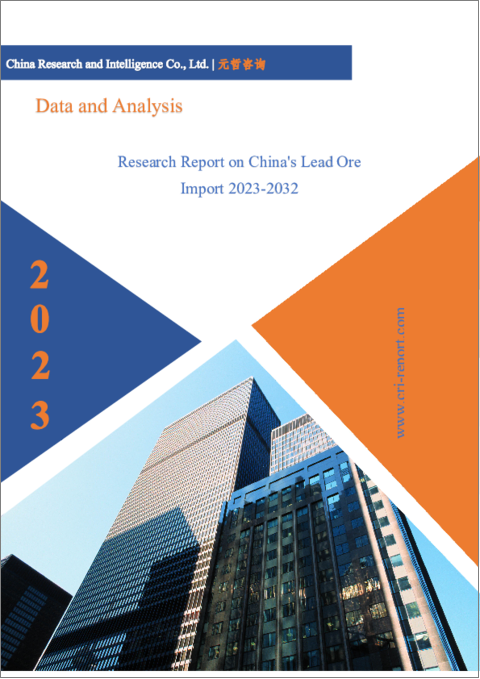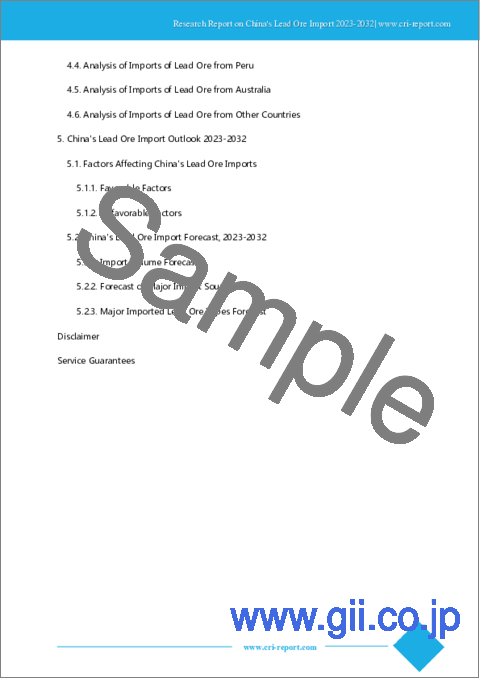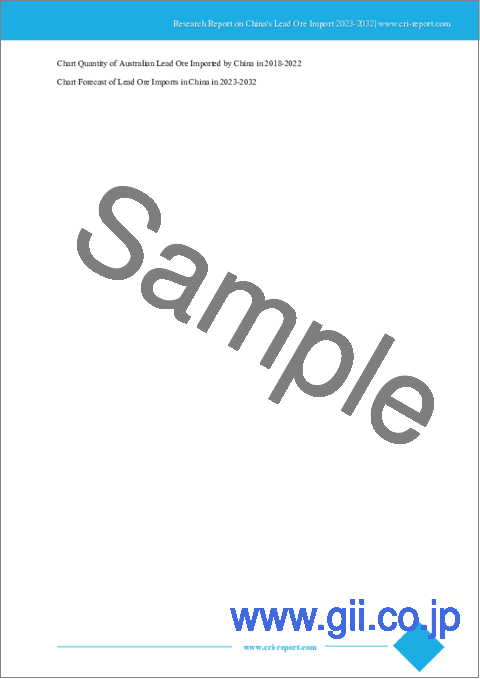|
|
市場調査レポート
商品コード
1164295
中国の鉛鉱石輸入の分析 (2023年~2032年)Research Report on China's Lead Ore Import 2023-2032 |
||||||
| 中国の鉛鉱石輸入の分析 (2023年~2032年) |
|
出版日: 2022年11月28日
発行: China Research and Intelligence
ページ情報: 英文 60 Pages
納期: 即日から翌営業日
|
- 全表示
- 概要
- 目次
鉛の主な用途は鉛蓄電池の製造であり、世界の自動車産業の成長に伴い、鉛の世界消費量は年々増加しています。2022年末には全世界で15億台以上の自動車が走ると言われています。そして、鉛蓄電池の耐用年数は一般的に3年以下であるため、世界では毎年大量の鉛蓄電池を交換する必要があります。中国は鉛蓄電池の世界の生産・輸出国ですが、中国国内の鉛鉱石の埋蔵量が不足しているため、毎年大量の鉛鉱石を輸入しなければなりません。
サンプルビュー
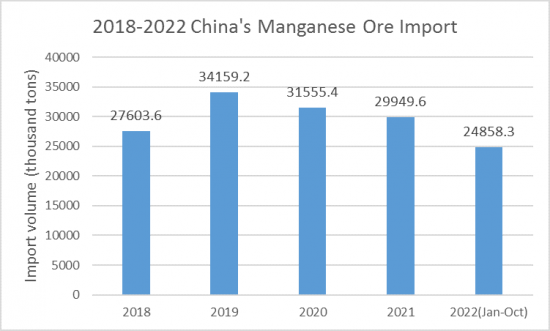
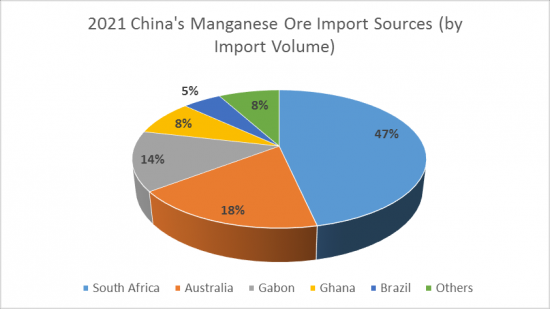
2021年、中国の鉛鉱石とその精鉱 (以下、鉛鉱石) の輸入量は119万3,000トン (前年比8.9%減)、輸入額は18億5,000万米ドル (前年比8.5%増) でした。2022年第1~3四半期の中国の鉛鉱輸入量は74万9,000トン (前年同期比13.4%減)、輸入額は11億米ドル (同17.0%減) となっています。中国の鉛鉱輸入量減少の主因は、COVID-19によるプラント着工数の減少に伴う中国国内の鉛鉱需要の減少です。2023年~2032年には、COVID-19による中国経済への悪影響が薄れ、中国市場の鉛鉱石需要が徐々に回復することが期待されます。
2018~2022年の第1~3四半期において、中国の鉛鉱石の平均輸入価格は、一般的に上昇の後に下降する傾向を示しています。2018年~2020年には1トン当たり1,300米ドル前後で概ね安定し、2021年には1トン当たり1551.8米ドル (前年同期比19.0%増) に達しています。2022年第1~3四半期は、中国の鉛鉱石の平均輸入価格は1トン当たり1473.5米ドル (前年同期比4.1%減) に下落します。
2021年、中国は合計39の国・地域から鉛鉱石を輸入しました。CRIの分析によると、中国の主な鉛鉱石輸入元 (数量ベース) は、ロシア、米国、トルコ、ペルー、オーストラリアです。中でもロシアは中国の最大の鉛鉱輸入元で、2021年には26万6,000トンの鉛鉱を輸入し (輸入量全体の22.3%)、輸入額は4億4,000万米ドル (輸入額全体の23.5%) に達しました。2021年には、米国がペルーを抜いて第2位の輸入元となり、輸入量は18万9,000トン (前年比37.1%増) に達します。
2023年から2032年にかけても、中国は毎年大量の鉛鉱石を輸入する必要があると予想されています。
当レポートでは、中国の鉛鉱石の輸入市場について分析し、全体的な輸入量・輸入額や主な輸入元 (2018年~2022年)、種類別の詳細動向、輸入価格の推移、主な市場促進・抑制要因、主要企業のプロファイルと戦略、今後の輸入動向の見通し (2023年~2032年)、といった情報を取りまとめてお届けいたします。
目次
第1章 中国の鉛鉱石輸入の分析 (2018年~2022年)
- 中国の鉛鉱石の輸入規模
- 中国の鉛鉱石の輸入量
- 中国の鉛鉱石の輸入額
- 中国の鉛鉱石の輸入価格
- 中国の鉛鉱石の見かけ消費量
- 中国の鉛鉱石の輸入依存度
- 中国の鉛鉱石の主な輸入元
- 輸入量
- 輸入額
第2章 中国の鉛粗鉱の輸入分析 (2018年~2022年)
- 輸入量
- 輸入額
- 輸入価格
- 輸入依存度
- 種類別の輸入分析
- 輸入量:種類別
- 輸入額:種類別
- 輸入価格:種類別
- 主な輸入元
- 輸入量
- 輸入額
第3章 中国の鉛精鉱の輸入分析 (2018年~2022年)
第4章 中国の鉛鉱石の主な輸入元の分析 (2018年~2022年)
- ロシアからの鉛鉱石の輸入分析
- 米国からの鉛鉱石の輸入分析
- トルコからの鉛鉱石の輸入分析
- ペルーからの鉛鉱石の輸入分析
- オーストラリアからの鉛鉱石の輸入分析
- 他の国々からの鉛鉱石の輸入分析
第5章 中国の鉛鉱石輸入の見通し (2023年~2032年)
- 中国の鉛鉱石輸入に影響を与える要因
- 有利な要因
- 不利な要因
- 中国の鉛鉱石輸入の予測 (2023年~2032年)
- 輸入量の予測
- 輸入量の予測:主な輸入元別
- 輸入量の予測:主な種類別
The main use of lead is in the manufacture of lead-acid batteries, and as the global automotive industry grows, global consumption of lead is increasing year by year. According to CRI analysis, by the end of 2022, there will be more than 1.5 billion vehicles worldwide. And the service life of lead-acid batteries is generally not more than 3 years, so the world needs to replace a large number of lead-acid batteries every year. China is the world's major producer and exporter of lead-acid batteries, and because China's local lead ore reserves are insufficient, China has to import a large amount of lead ore every year.
SAMPLE VIEW


In 2021, China imported 1.193 million tons of lead ore and its concentrates (referred to as lead ore, hereinafter), down 8.9% year-on-year, and the import value was US$1.85 billion, up 8.5% year-on-year. In the first three quarters of 2022, China imported 749,000 tons of lead ore, down 13.4% year-on-year, and the import value was US$1.10 billion, down 17.0% year-on-year. The main reason for the decline in China's lead ore imports in 2021-2022 is the decline in demand for lead ore in China due to lower plant starts as a result of COVID-19. Demand for lead ore in the Chinese market is expected to recover gradually in 2023-2032 as the adverse effects of COVID-19 on the Chinese economy fade away.
In the first three quarters of 2018-2022, the average price of China's lead ore imports generally shows a trend of increasing before decreasing. According to CRI analysis, in 2018-2020, the average price of China's lead ore imports fluctuates slightly but is generally stable at around US$1300 per ton, and in 2021, the average price of China's lead ore imports rises to US$1551.8 per ton, up 19.0% y-o-y. In the first three quarters of 2022, the average price of China's lead ore imports falls to US$1473.5 per ton, down 4.1% year-on-year.
In 2021, China imported lead ore from a total of 39 countries and regions. CRI analysis shows that China's major sources of lead ore imports by import volume are the Russian Federation, the United States, Turkey, Peru and Australia. Among them, the Russian Federation is China's largest source of lead ore imports, with China importing 266,000 tons of lead ore from the Russian Federation in 2021, accounting for 22.3% of the total import volume and the import value of US$440 million, accounting for 23.5% of the total import value. In 2021, the U.S. overtook Peru as China's second largest source of lead ore imports, with the import volume reaching 189,000 tons, up 37.1% year-on-year.
CRI expects that China will still need to import large amounts of lead ore each year from 2023-2032.
Topics covered:
- China's Lead Ore Import Status and Major Sources in 2018-2022
- What is the Impact of COVID-19 on China's Lead Ore Import?
- Which Companies are the Major Players in China's Lead Ore Import Market and What are their Competitive Benchmarks?
- Key Drivers and Market Opportunities in China's Lead Ore Import
- What are the Key Drivers, Challenges, and Opportunities for China's Lead Ore Import during 2023-2032?
- What is the Expected Revenue of China's Lead Ore Import during 2023-2032?
- What are the Strategies Adopted by the Key Players in the Market to Increase Their Market Share in the Industry?
- What are the Competitive Advantages of the Major Players in China's Lead Ore Import Market?
- Which Segment of China's Lead Ore Import is Expected to Dominate the Market in 2032?
- What are the Major Adverse Factors Facing China's Lead Ore Import?
Table of Contents
1. 2018-2022 China's Lead Ore Import Analysis
- 1.1. China's Lead Ore Import Scale
- 1.1.1. China's Lead Ore Import Volume
- 1.1.2. China's Lead Ore Import Value
- 1.1.3. China's Lead Ore Import Price
- 1.1.4. China's Apparent Lead Ore Consumption
- 1.1.5. Import dependence of lead ore in China
- 1.2. Major Import Sources of Lead Ore in China
- 1.2.1. By Import Volume
- 1.2.2. By Import Value
2. China's Coarse Lead Ore Import Analysis 2018-2022
- 2.1 Coarse Lead Ore Import Volume
- 2.2. Coarse Lead Ore Import Volume
- 2.3. Coarse Lead Ore Import Price
- 2.4 Import Dependence of Coarse Lead Ore
- 2.5 Analysis of Coarse Lead Ore Import by Type
- 2.5.1 Import Volume of Coarse Lead Ore by Type
- 2.5.2. Import Value of Coarse Lead Ore by Type
- 2.5.3. Import Price of Various Types of Coarse Lead Ore
- 2.6 Sources of Coarse Lead Ore Imports
- 2.6.1. By Import Volume
- 2.6.2. By Import Value
3. 2018-2022 China Lead Ore Concentrate Import Analysis
- 3.1. Import Volume of Lead Ore Concentrate
- 3.2. Import Value of Lead Concentrate
- 3.3. Import Price of Lead Concentrate
- 3.4 Import Dependence of Lead Concentrate
- 3.5 Analysis of Import of Lead Concentrate by Type
- 3.5.1 Import Volume of Lead Concentrate by Type
- 3.5.2. Import Value of Lead Concentrate by Type
- 3.5.3. Import Price of Lead Concentrate by Type
- 3.6 Sources of Lead Concentrate Imports
- 3.6.1. By Import Volume
- 3.6.2. By Import Value
4. 2018-2022 Analysis of the Main Import Sources of Lead Ore in China
- 4.1 Analysis of Imports of Lead Ore from the Russian Federation
- 4.2. Analysis of Imports of Lead Ore from the United States
- 4.3 Analysis of Imports of Lead Ore from Turkey
- 4.4 Analysis of Imports of Lead Ore from Peru
- 4.5 Analysis of Imports of Lead Ore from Australia
- 4.6 Analysis of Imports of Lead Ore from Other Countries
5. China's Lead Ore Import Outlook 2023-2032
- 5.1 Factors Affecting China's Lead Ore Imports
- 5.1.1 Favorable Factors
- 5.1.2. Unfavorable Factors
- 5.2. China's Lead Ore Import Forecast, 2023-2032
- 5.2.1 Import Volume Forecast
- 5.2.2. Forecast of Major Import Sources
- 5.2.3. Major Imported Lead Ore Types Forecast
